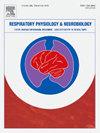反复呼吸暂停时氧合、潜水反应和不自主呼吸运动的渐进式变化。
IF 1.6
4区 医学
Q3 PHYSIOLOGY
引用次数: 0
摘要
目的:本研究调查了训练有素的自由潜水员是否可以在没有进行性动脉或脑氧饱和度下降的情况下维持1:1的呼吸恢复比。方法:21名训练有素的自由潜水员(6名女性)在仰卧的实验室环境中进行了7次固定持续2分钟的静态呼吸,每次静止呼吸后休息2分钟。连续测定血氧饱和度(SpO₂)和心率(HR)。近红外光谱(NIRS)评估大脑和周围肌肉氧合。胸力传感器记录了不自主呼吸运动(IBM)。呼吸暂停前后分别测量潮末CO₂(EtCO₂)。结果:SpO₂在第一次呼吸暂停期间下降最多(94±3%),但此后趋于稳定(p结论:1:1的呼吸恢复比在训练自由潜水员休息时是生理上可持续的,不会引起进行性氧饱和度降低。最初的呼吸暂停引起了最强的保氧反应,在整个系列中逐渐减弱,这表明在重复的亚最大呼吸暂停期间的生理调节是适应特定情况的需求的。尽管二氧化碳水平稳定,但渐进式IBM延迟表明,除了化学反射驱动的呼吸刺激之外,还有其他机制可能有助于通气驱动。本文章由计算机程序翻译,如有差异,请以英文原文为准。
Progressive changes of oxygenation, diving response, and involuntary breathing movements during repeated apneas
Purpose
This study investigated whether trained freedivers can sustain a 1:1 apnea-to-recovery ratio without progressive arterial or cerebral oxygen desaturation.
Methods
21 trained freedivers (6 females) performed 7 static apneas of fixed 2-min duration, each followed by 2-min of rest, in a supine laboratory setting. Arterial oxygen saturation (SpO₂) and heart rate (HR) were measured continuously. Near-infrared spectroscopy (NIRS) assessed cerebral and peripheral muscle oxygenation. A chest force sensor recorded involuntary breathing movements (IBM). End-tidal CO₂ (EtCO₂) was measured pre- and post apnea.
Results
SpO₂ declined most during the first apnea (94 ± 3 %) but stabilized thereafter (p < 0.005). Lowest HR increased from 61 ± 15 to 65 ±13 bpm across the series (p = 0.02), and the intial apnea tachycardia declined by 10 bpm (p = 0.012). Cerebral oxygenation increased above baseline only during the first apnea (1.0 ± 2.3 %); in subsequent apneas it remained stable, although slightly below baseline. Muscle oxygenation declined during all apneas but was more pronounced in the first (-6.7 ± 3.1 %). IBM onset was progressively delayed; 63 % of participants showed no IBM during the final apnea. EtCO₂ increased after each apnea by ≈ 1.0kPa (p < 0.001) but did not change progressively across the series.
Conclusion
A 1:1 apnea-to-recovery ratio was physiologically sustainable in trained freedivers at rest, without inducing progressive oxygen desaturation. The initial apnea elicited the strongest oxygen-conserving responses, which progressively attenuated across the series, suggesting that physiological regulation during repeated submaximal apneas is adaptable to meet situation-specific demands. The progressive IBM delay despite stable CO2 levels suggests additional mechanisms beyond chemoreflex-driven stimulation of breathing may contribute to ventilatory drive.
求助全文
通过发布文献求助,成功后即可免费获取论文全文。
去求助
来源期刊
CiteScore
4.80
自引率
8.70%
发文量
104
审稿时长
54 days
期刊介绍:
Respiratory Physiology & Neurobiology (RESPNB) publishes original articles and invited reviews concerning physiology and pathophysiology of respiration in its broadest sense.
Although a special focus is on topics in neurobiology, high quality papers in respiratory molecular and cellular biology are also welcome, as are high-quality papers in traditional areas, such as:
-Mechanics of breathing-
Gas exchange and acid-base balance-
Respiration at rest and exercise-
Respiration in unusual conditions, like high or low pressure or changes of temperature, low ambient oxygen-
Embryonic and adult respiration-
Comparative respiratory physiology.
Papers on clinical aspects, original methods, as well as theoretical papers are also considered as long as they foster the understanding of respiratory physiology and pathophysiology.

 求助内容:
求助内容: 应助结果提醒方式:
应助结果提醒方式:


